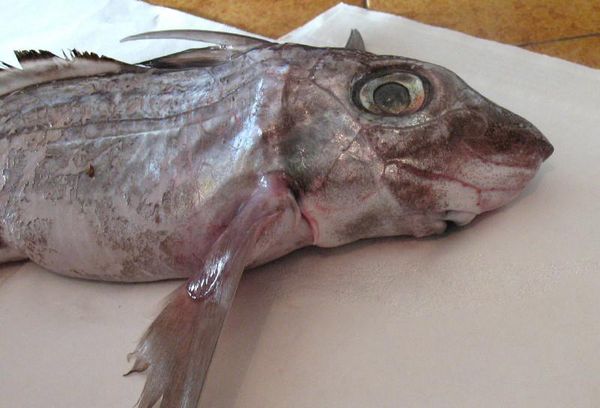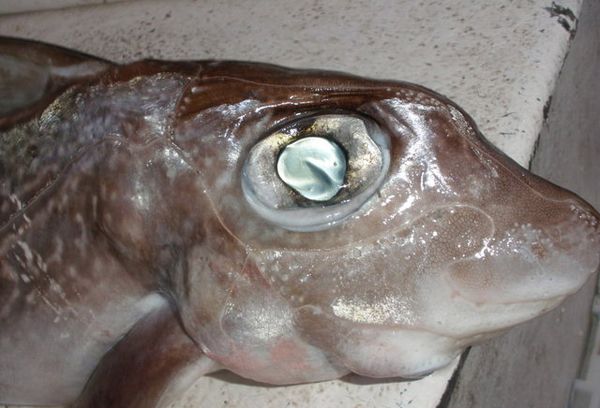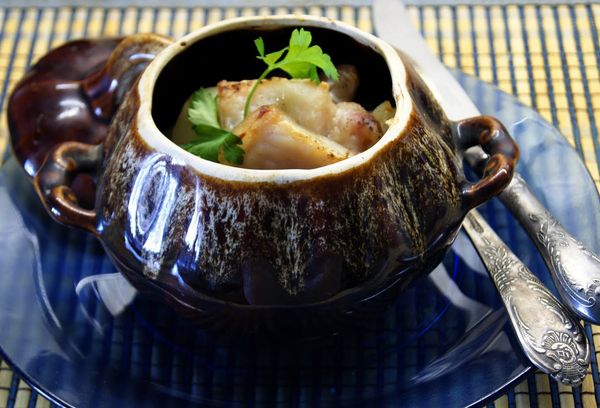Fish rabbit cooking recipes. Sea hare - a fish from the Pacific Ocean
Many people are not familiar with this sea fish like a fish hare. If you are interested in knowing what this sea creature is, then this article is for you. We will discuss whether there are benefits from this fish. We will also find out if it carries any harm to the human body.
To see this fish in full, you need to refer to the guide. The thing is, it's not for sale. You can only buy fragments of her fish body, so to speak. They are sold in their pure form. Therefore, it is very difficult to understand what kind of fish it is in its original form. A lot of deception exists on the fish counters. Since a hare is often given out for a fish simple hake or pollock. Cod-shaped small fish are like our marine individual.
What is a hare fish?
This fish is cartilaginous. She doesn't have a bubble. Therefore, in order to stay afloat, she constantly needs to be on the move. Like the shark, this fish will otherwise just fall to the seabed. A hare is cooked like any other fish. It must be salted, then covered with flour or batter, and then fried in a hot frying pan.
Some sources indicate that this fish emits bad smell. But it's not. Although the smell of a hare is not as pleasant as the smell of cod, it does not stink outrageously. The taste of the finished fish is simply amazing. In ordinary fish there are bones, in the same cartilage. Thanks to this structure, fish meat is very easy to separate with cutlery.
Benefit and harm
Distrust of our fish is due to the fact that it is considered an exotic product, and many people know absolutely nothing about it. In fact, hare fish meat is very nutritious and juicy. This fish was considered unfit for consumption only until the twentieth century. Now it is a rare delicacy in many expensive restaurants peace. 
She is very helpful. It contains a lot of protein, which is easily and quickly absorbed by the human body. It also contains a lot of vitamins such as A, E, and D. Moreover, this fish is filled with useful minerals. Since fish contains a large amount fatty acids, its meat is considered especially nutritious. The calorie content of fish is such that one hundred grams of its meat accounts for one hundred and sixteen kcal.
Is there any harm in eating this fish? You can suffer only in case of personal intolerance to this marine product. Also, our hare has a poisonous fin. This is the top fin. Separate the carcass of fish because of this should be done with extreme caution. The fish is quite oily. It shouldn't be abused.
additional information
The fish has expressive eyes. Apparently, this is the reason that she was given such a name as a hare. But more than that, she is nothing like an ordinary hare. Since the fish lead an unusual lifestyle, they are sometimes called the rats of the seas. They feed on solid foods such as shellfish or crayfish. The jaws of the fish are very powerful, so the catchers are very careful with this fish. The hare lays eggs. Scandinavians eat these eggs.
The price point is not defined. Fish prices fluctuate. In general, hare fish costs a little more than simple cod. But not in every store you will find our fish. You are more likely to find this delicacy in specialty seafood stores. Hare fish is also an aquarium type. It is decorative and is not eaten. This fish is very expensive.
It is believed that sellers sell fish much more expensive than the price. They may invent their own names for hare fish to show it as more rare and expensive fish. Some even sell tasteless fish with tough meat passing her off as a chimera. It is easy to fall for such a scam.
The fact that the fish has a rather funny nickname. This suggests that it is not extremely rare. Abroad, it is found in many restaurants. Do not be afraid and believe all the nonsense about hare fish that can be found in various sources. This fish is both healthy and tasty, and not very expensive.
If you have a chance to try the meat of this fish, do not deny yourself such a pleasure. Be sure to try this one. Its taste is reminiscent of shark meat. Therefore, not everyone will like it as a main dish. So, now you know what a hare fish is. You know how it is useful, and whether it can be dangerous. You have all the information you need about our exotic fish. You know what a hare fish can become great addition to your overall diet.
Recipe (video)
In some stores you can find exotic products, which for many are unknown, therefore, cause mistrust. Sea hare fish, the benefits and harms of which will be discussed, in the store can be mistaken for a more familiar hake or pollock, since the carcasses are sold without a head. Another name for this fish is a chimera. Those who have tried this product like the fact that instead of bones, this fish has breast-like cartilage, and there are no small bones at all. The meat is very tasty and juicy.
The benefits and harms of a bearded seal
Until the beginning of the 20th century, the chimera was considered an inedible fish, but today, in many restaurants in Europe, its fillet is considered a real delicacy. Beneficial features chimera fish are justified by the presence a large number easily digestible protein, E, D, as well as various minerals. Given the presence of fatty acids, chimera fish is very nutritious. Many are interested in calorie content, and so 100 g of the product contains 116 kcal.
As for the harm of hare or chimera fish, some people may have an individual intolerance to the product. It is worth saying that the upper fin of this fish is poisonous, so you need to cut the carcass as carefully as possible. Since the chimera is oily fish, then you should not eat it in large quantities.
Fish hare in pots
Ingredients:

Cooking
Remove the spine from the steaks and cut them into small squares. Chop the vegetables and cheese into small cubes, and chop the greens. Combine ingredients and add lemon juice to it. To prepare the dressing, mix together the oyster sauce, olive oil and add salt and pepper to it. put into pots, add butter and sprinkle with cheese. Pour in the dressing, put in the oven and cook at 200 degrees for 20 minutes.
What are different and unusual fish exist in nature, and what names are not invented for them! For example, a chimera fish: the name of this animal alone evokes not the most pleasant associations. And if you look at this inhabitant sea depths, opinions may differ. Some see a very cute and cute fish that looks like a soaring bird, while others see a monster. So who is she really, this mysterious marine inhabitant, who is also called by another strange name - sea hare fish.
Very close relatives of the chimera are and: they are all cartilaginous fish and have a spine made of cartilaginous tissue. Look at the photo of chimera fish and try to find similarities with sharks!
All the most interesting about chimeras
When the name chimera is mentioned, it does not mean that there is only one single species. The genus Chimera (lat. Chimaera) combines 6 species, of which the most famous is the European chimera (lat. Chimaera monstrosa) from the eastern Atlantic. There is a Cuban chimera (Chimaera cubana), which at first was taken for a European one, but was later separated into an independent species. It lives off the coast of Cuba at a depth of 400-500 meters. Other species of the genus Chimera are known from the waters of the eastern regions of the Pacific Ocean (Philippines, the Yellow Sea and the Japanese Islands).
The place of chimeras in the fish system
The genus Chimera, of which the European chimera is a representative, is included in the Chimaeridae family, in which there is another genus with species that differ from the genus Chimera in the shape of the caudal fin.
All fish of the Chimera family have a blunt snout. This is an important difference from other families of the Chimaeriformes order, among which there is a family. Nosed chimeras with a very elongated snout, and pointed at the end. And the third family is the proboscis-snouted chimeras (callorhynchus). They are distinguished by an elongated and bent down and backward anterior end of the snout.
Below, in the photo, chimera fish are shown in the drawings, and you can see the differences in the structure of the snout in the representatives of each family, which were mentioned above.
 Representatives of the chimera order: 1 - fam. Chimera; 2 - family. Proboscis (callorhynchaceae) and fam. Nosed chimeras.
Representatives of the chimera order: 1 - fam. Chimera; 2 - family. Proboscis (callorhynchaceae) and fam. Nosed chimeras. As mentioned at the beginning of the article, the chimera fish is cartilaginous, and, accordingly, belongs to the class "Cartilaginous fish", which has two subclasses. Having much in common in the internal and external structure with elasmobranchs (sharks and rays), chimeras differ from them in that their upper jaw is completely fused with the skull. Therefore, they are distinguished into a subclass of Whole-Headed or Fusion-Cranial.
Appearance of chimeras
All chimeras have a characteristic body shape: valky, slightly compressed from the sides and very thinning towards the tail. In the photo of the sea hare fish (European chimera), this is clearly visible.

Other features of the appearance of chimera representatives:
- Two fins on the back, the first one is high and short, having a powerful spike in front, which together with it, if necessary, fit into a special groove in the back. The second is long and can stretch to the very base of the caudal fin and does not fold.
- The tail fin is often shaped like a long cord.
- The pectoral fins are very well developed and each of them resembles a fan in shape.
- The pelvic fins are smaller than the pectoral fins and are located near the anus, being pushed back.
- At the base, all paired fins are equipped with fleshy lobes, thin and flexible.
- The mouth located below (lower) in chimeras and has a characteristic three-lobed upper lip.
- The gill openings on the sides of the head are covered by a fold of skin supported by finger-like cartilages.
- The naked body, devoid of placoid scales, is covered big amount mucus.
 A spine in the first dorsal fin of a European chimera.
A spine in the first dorsal fin of a European chimera. European chimeras - beauties or monsters?
The European chimera bears the Latin name Chimaera monstrosa, which evokes associations with some kind of monster. This fish has many names, one of the names that a chimera fish has is a hare. Perhaps this is due to the large slightly elongated pectoral fins and huge eyes. It is also called the sea rabbit fish, apparently for the same reasons.
And the Norwegians have a chimera - this is king fish. So it is called because of the thin bone outgrowth bent backwards, which is located in males between the eyes.
 A stylized image of a male chimera with a bony growth between the eyes.
A stylized image of a male chimera with a bony growth between the eyes. The body length of the European chimera can be up to one or one and a half meters, and its tail is very long and thin, so another name has been assigned to it - the sea rat.
What color is a chimera?
Rudimentary spines are sometimes found on the bare skin of the European chimera. However, the skin looks smooth and soft and has a characteristic color:
- back in dark brown and golden hues in combination with brown and whitish, a dark brown stripe stretches along the upper back;
- the ventral side of the body is light;
- on the back of the long dorsal fin, as well as on the caudal and anal, a blackish-brown edging is noticeable.
Completes the Chimera's color look green color pupil against the white iris of her huge eyes.
 European chimera, photo by Roman Fedortsov, Murmansk, @rfedortsov_official_account
European chimera, photo by Roman Fedortsov, Murmansk, @rfedortsov_official_account Distribution, lifestyle and movement
The European chimera fish is not found in tropical waters. Its range is the eastern part of the Atlantic Ocean:
- In northern waters - from the Strait of Gibraltar (coastal waters of Morocco) to the island of Iceland and the Scandinavian Peninsula with entry into the Barents Sea.
- Southern waters - off the coast of southern Africa (this information needs to be confirmed).
The sea hare fish spends most of its life at the bottom, so ichthyologists refer to it as a bathydimersal (bottom deep-sea) fish. After all, the depth at which you can meet it is from 40 to 1400 meters. But most often this species lives at relatively shallow depths: two hundred to five hundred meters (in the northernmost part of the range) and three hundred and fifty to seven hundred meters (in the waters off the coast of Morocco). By winter, it comes to coastal waters, where off the coast of Norway (where the depth is from 90 to 180 meters), a certain number of individuals can be caught by trawls.
These fish are quite gentle, they do not resist at all when caught. Removed from the water, they die very quickly. Placed in an aquarium, they do not survive well.
Way to travel
Chimera or sea rabbit fish is not a fast and high-speed swimmer, and she does not need it. See how gracefully it moves with the eel-like curvature of the back of the body and tail and the wave-like flapping of large pectoral fins that resemble wings. The pelvic fins are also involved in ensuring the swimming of the fish, located horizontally, they perform the function of movement stabilizers.
Being near the bottom, chimeras can "stand" on the ground, relying on almost all of their fins: while the pectoral and ventral fins perform the function of four limbs, and the tail serves as an additional support.
The question of nutrition
This part of the article is devoted to two questions:
- what does sea rabbit fish eat;
- Is it possible to eat chimera fish, that is, a sea rabbit?
The diet of chimeras is represented mainly by benthic invertebrates. Among them are molluscs, crustaceans (mainly crabs), echinoderms ( sea urchins, ophiurs). small fish only sometimes caught in their stomachs. When examining the contents of the digestive tract of chimeras, it was found that they do not swallow food whole, but bite off prey small pieces or crush it with strong dental plates.
Do people eat chimeras?
So, is it possible to eat chimera fish. There is no categorical answer to this question. Fishing for chimeras is carried out off the Pacific coast of the United States, they are caught in Chile and Argentina, as well as in the waters of New Zealand and China. Especially large are the volumes of prey in New Zealand, where representatives of the Callorhynchus family (proboscis-nosed chimeras) are caught.

Only fresh callorhynchus meat is suitable for eating, which has excellent taste qualities. However, if it lies down even a little, it begins to exude an unpleasant smell of ammonia. For housewives, cartilaginous chimera fish, which does not have scales and hard bones, is, of course, very convenient to cook.
From the liver of chimeras, fat is extracted, which has long been known as an excellent wound healing agent.
The current trend towards increasing European chimera harvesting by deep sea trawling to produce medicines from the liver oil of this fish has caused this species to be listed in the IUCN (International Union for Conservation of Nature) Red List. The chimera hare fish has a conservation status, as a species close to a vulnerable position.
Many people do not even know what kind of fish it is - a sea hare. The benefits and harms of the product, the features of its catch and preparation for a long time remained a mystery to the inhabitants of our country. Some suppliers of goods even tried to cash in on this gap, artificially inflating the price of products, inventing various myths with it. In fact, the sea hare is delicious and useful fish, which is undemanding to processing. And its cost should not exceed the price for the usual cod.
Sea hare - description and features of fish
Finding a whole sea hare in the market or in a grocery store is not so easy. Usually the fish is cut up and sold in parts. If you want to treat yourself to an unusual representative of the seas, you should look at a lot of pictures. Otherwise, there is a risk of acquiring an ordinary hake or cod for a disproportionate price. By the way, the cost of a bearded seal should not be high, even if it really is.
Unusual fish is noticeably different from marine representatives familiar to the modern consumer. She does not have a bubble, so she has to constantly move like a shark in order not to drown. Her skeleton is made up of cartilage, not bones. This greatly simplifies the process of working with finished product cutlery.
The composition and benefits of the bearded seal
Culinaries of many European countries very actively use the sea hare to create their masterpieces. In addition to the unusual and memorable taste, the fish is able to boast a rich chemical composition. At regular use the product can have a beneficial effect on the health of adults and children.
- The meat of individuals is rich in protein, which is easily and quickly absorbed by the body. Nutritious but not overly high-calorie product(about 116 kcal per 100g) quickly satisfies hunger and does not create a burden on the heart and kidneys.
Tip: There is also an aquarium variety of sea hare fish. It's really quite rare and expensive. It is not suitable for food! Need to see before buying basic information about the differences between individuals, in order not to let a commercial specimen into the aquarium, for which a tidy sum had to be paid.

- Fish is rich in vitamins A, E and D. They support the work of a number of systems and organs, remove toxins from the body, and promote the absorption of important mineral elements.
- Minerals, which are also numerous in fibers, take an active part in metabolic processes. They support the functionality of the endocrine glands at the right level, stimulate water exchange in cells and tissues.
- The abundance of beneficial fatty acids allows the use of fish for blood purification. Removal of harmful cholesterol from the body reduces the likelihood of developing atherosclerosis, hypertension and other unpleasant conditions.
In general, the meat of a unique fish is very juicy, soft, but at the same time fibrous. Even if you just salt the workpiece, roll it in batter and fry, you can get gourmet delicacy. Some cooks can talk about dozens of ways to prepare a bearded seal.
Harm of the sea hare
Exotic fish can be harmful in several cases, so before buying it, you should familiarize yourself with the following nuances:
- The sea hare has a poisonous fin located at the top of the carcass. Therefore, you need to cut it carefully or you can buy ready-made parts of the product.
- Fish, though not so high-calorie, but quite fatty. Abuse of the delicacy can lead to unnecessary weight gain.
- Don't forget that New Product may cause allergies. Before introducing a sea hare into the diet, you need to try it by eating a very small amount.
- It is easier to work with a butchered carcass, but the likelihood that whole carcass been frozen and thawed several times, much lower. This manipulation affects not only appearance fish, but also greatly impairs its taste characteristics. By the way, the benefits of repeatedly thawed fillets tend to zero.

Finally, eating low-quality or stale fish can lead to poisoning. This will not happen if you buy products with transparent and shiny eyes, red and completely closed gills. Any flaws in the appearance or smell of products should alert. Especially if it is a frozen product and it is not so easy to evaluate its quality.
Cooking methods
Among the many options for cooking a sea hare, the following recipes occupy a special place:
- Per 0.5 kg fish blanks we need 2 tablespoons of olive oil, a teaspoon of curry, 1 cucumber and carrots, 7 olives and black olives, salt, pepper and herbs.
- We prepare the mixture from salt, pepper, oil, herbs and curry. We rub the fish with it and wrap it in foil for baking.
- We bake the workpiece for 30 minutes in the oven at a high temperature.
- After that, we insist the fish in foil for another 10 minutes, during which time we cut the vegetables figuratively. Put the sea hare on a dish and decorate beautifully.

- For 1 kg of fish we take 1 glass vegetable broth And pomegranate juice, onion, a couple of cloves of garlic, a tablespoon of tomato paste, a little vegetable oil, half a glass of low-fat nuts, salt and flour.
- We clean the fish, wash it, cut into pieces. Roll them in flour with salt and fry in vegetable oil.
- chop the pepper and onion finely chop, rub the garlic. Mix these ingredients with broth, juice, tomato paste and heat over medium heat.
- As soon as the sauce boils, lower the fish into it and simmer it for another 10 minutes. Serve with boiled rice.

Sea fish in pots:
- On 2 fish steak take 2 potatoes and onions, 1 carrot, 100 g hard cheese, 2 tablespoons of butter and olive oil, a bunch of parsley, dill and green onions, juice of half a lemon, salt and pepper.
- We clean the steaks from cartilage and cut into portioned squares. Chop the onion and carrot into short strips, chop the potatoes into cubes. Greens chop, mix, water lemon juice. We cut the cheese into cubes.
- In a separate bowl, mix olive oil with pepper, you can add a tablespoon for taste. oyster sauce. We insist the mass for several minutes.
- We put pieces of fish in warm pots, cheese, onions and carrots, potatoes on them. Sprinkle everything with herbs, spread the butter and a little more cheese. Pour all this with oil dressing, cover with lids and send to the oven.
- The processing time is at least 40-45 minutes. The readiness of the dish should be checked by potatoes.

Today, the bearded seal is found even in freshwater reservoirs, so do not be surprised by such information on the package. This moment does not affect the quality of meat in any way. The approach to processing and cooking products in this case will be exactly the same.
By the way, an exotic individual looks like a hare only with large and transparent eyes. The appearance of the carcass is very specific and not the most appetizing. But you don't have to be afraid of it. If you have the opportunity to taste unusual meat, you should take it. Few are negative about taste characteristics fish, and most often negative feedback occur as a result of mishandling.
chimera fish
The deep waters of the mysterious oceans are inhabited by mysterious creatures. 400 million years ago, evolution appeared an unusual underwater inhabitant - a chimera fish.
This creature is sometimes called ghost sharks. And this fish got the name chimera for its appearance. The fact is that in Greek mythology there was a legend about a monstrous woman, whose entire body was formed from parts of different animals. Seeing a fish with a strange appearance, the ancient Greeks decided that its body did not at all look like an ordinary representative of fish - but as if it was also made up of parts of animals. That is why the chimera fish got its name.
Deep Sea Chimera Fish
This fish belongs to the cartilaginous, represents the chimera order, the chimera family.
Among the class of cartilaginous fish, chimeras appeared on our planet as the very first. They are considered distant relatives sharks Today, scientists have counted about 50 species of these unusual fish on our planet.
The appearance of the chimera fish
The body length of an adult reaches 1.5 meters. The skin of these fish is smooth, with multi-colored tints. In males, between the eyes on the head there is a bone outgrowth (thorn), which has a curved shape.
The tail of these fish is very long, it reaches a size equal to half the length of the entire body. A feature of the appearance of these representatives of the chimera family can be called large wing-shaped lateral fins. Straightening them, the chimera becomes something like a bird.













